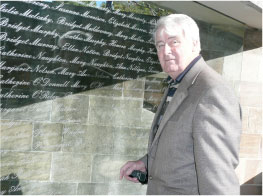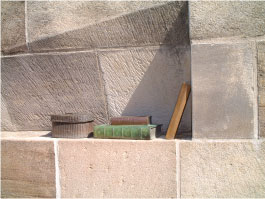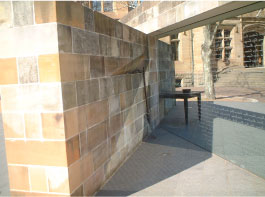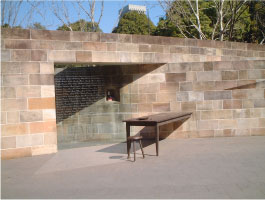BACKGROUND TO THE MONUMENT
President Mary Robinson enthralled all who came to hear her during her visit to Sydney in 1995 when she called on the Irish community to mark the memory of the Great Irish Famine (1845-1848) in some special way. At this time there were many active Irish County organisations in Sydney, all doing their own thing and loosely co-ordinated by a body called The Irish Communication Council headed by Mayo born, Martin Coleman.
 In November 1995 a meeting of all the County associations was called to discuss pursuing the seeds of the idea sown by President Robinson to mark the Famine. In February 1996 a sub-committee of the Communications Council was elected to discuss the ‘commemoration’. Tom Power was elected as Chairman (pictured at the monument in 2009), Ian Caruth as Vice-President and Terrie Pollard as Secretary.
In November 1995 a meeting of all the County associations was called to discuss pursuing the seeds of the idea sown by President Robinson to mark the Famine. In February 1996 a sub-committee of the Communications Council was elected to discuss the ‘commemoration’. Tom Power was elected as Chairman (pictured at the monument in 2009), Ian Caruth as Vice-President and Terrie Pollard as Secretary.
Many ideas were discussed including the placement of a large rock at North Head. A figurative memorial at a proposed cost of $35,000 was also suggested. Tenders were called from six well-known and established artists and their maquettes were submitted to the committee. Hyde Park Barracks, designed by convict architect, Francis Greenway and in the care of the Historical Houses Trust of NSW (HHT), was considered the most appropriate site among other discussed locations. This building not only housed the first orphan girl arrivals in 1848 but was home to hundreds of Irish convict men prior to 1848.
In June 1996 the Trustees of HHT met with the Committee and examined the submitted maquettes but none were deemed suitable. Both organisations agreed to work together to develop a brief for a sculpture at the site and fund a limited competition among ‘recognised and acclaimed’ artists. The draft brief was presented to the Trustees in February 1997 and a Steering Committee, later known as the Sculpture Committee, was formed to manage the project. Its members were:
• Dinah Dysart, Chairperson & Trustee of the Historic Houses Trust of NSW
• Michael Bogle, Secretary & Curator of the Hyde Park Barracks Museum
• Tom Power, Chairman, Irish Famine Commemoration Committee
• Sally Couacaud, Sydney City Council advisor on public art
• Martin Coleman, Irish Famine Commemoration Committee
• Dr Shirley Fitzgerald, Trustee & City of Sydney Historian
• Professor Joan Kerr, Trustee of Historic Houses Trust
• Peter Tonkin, Architect
A brief was developed and two possible locations for the sculpture were suggested. One was the forecourt of the Hyde Park Barracks and the other was the southern wall of the Barrack enclosure. Due to outside influences and a number of irate phone calls, the forecourt location was abandoned. Apparently, some considered the sight of a famine orphan would be too confronting because of the proximity of Queen Victoria’s statue on the opposite side of the forecourt. In March 1997 the Sculpture Committee agreed that the southern wall would be a more appropriate location.
On 27 June 1997 the Lord Mayor, Councillor Frank Sartor, wrote encouragingly of the project and suggested that artists be invited to respond to both locations. He pointed out that ‘given the heritage aspect of the precinct and the strong spatial geometry of the square’ the forecourt could be too constraining for the artist. He also requested a senior Council employee be co-opted to the committee. Two senior Council employees attended the July meeting where it was decided that the artists would be invited to respond only to the southern wall site, much against the wishes of Tom Power and Martin Coleman who were the Irish Famine Monument representatives on the Sculpture Committee.




 In November 1995 a meeting of all the County associations was called to discuss pursuing the seeds of the idea sown by President Robinson to mark the Famine. In February 1996 a sub-committee of the Communications Council was elected to discuss the ‘commemoration’. Tom Power was elected as Chairman (pictured at the monument in 2009), Ian Caruth as Vice-President and Terrie Pollard as Secretary.
In November 1995 a meeting of all the County associations was called to discuss pursuing the seeds of the idea sown by President Robinson to mark the Famine. In February 1996 a sub-committee of the Communications Council was elected to discuss the ‘commemoration’. Tom Power was elected as Chairman (pictured at the monument in 2009), Ian Caruth as Vice-President and Terrie Pollard as Secretary.
